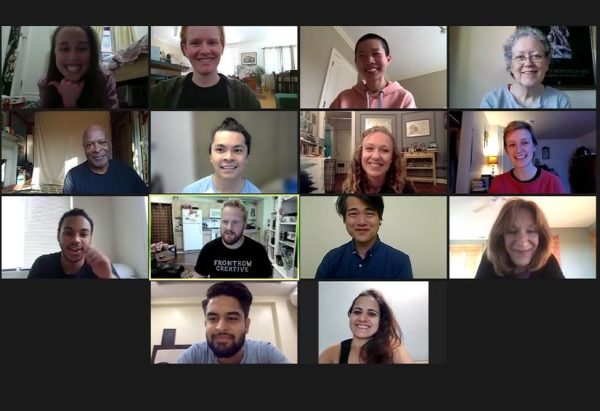Author: Bella Merlin
Who? When? Where?
Take an unknown actress. Add a nationally celebrated playwright.
Put them together in a creative and romantic alliance – and the result is explosive.
The dramatis personae in question are Tilly and Frank Wedekind.
The time is the early 20th century.
The place is Munich, Germany.
Why this piece?
As an actor, I have a passion for practice-as-research. Which basically means finding ways of putting historical, cultural and archival material into the body and sharing the results with a live audience. I’ve been fascinated by Frank and Tilly Wedekind since I played Wedekind’s iconic Lulu in London in the 1990s. I’d come across Tilly Wedekind’s autobiography: Lulu – Die Rolle Meines Lebens (Lulu: The Role of my Life) in German – and I knew there were some real gems inside. I was curious: Had Tilly had called her autobiography Lulu: The Role of my Life because the part was so immense that it launched her whole career? No! As I read Tilly’s words, I began to discover the truth. Lulu was the role of Tilly’s life because Frank had turned her into Lulu in the course of their marriage. This state of affairs ultimately led to her attempted poisoning and subsequent rehabilitation in a sanatorium. As I fathomed the truth of Tilly’s autobiography, I felt a deep connection with her – a woman long since dead in a different culture. Or is it…?
How did it come about?
Researching the piece, I went with my director, Miles Anderson, Munich. We walked the streets, sat in the cafes, saw the apartment and visited the theatre where Frank and Tilly had worked. We also went to the Wedekinds’ archive and poured over letters scripted by Tilly. Two struck us in particular – one written on tiny paper in tiny handwriting from the sanatorium when she was recovering from her poisoning: it was addressed to a theatre director with whom she wished to work. The second was in huge scrawling letters on a big piece of paper to a lover who had spurned her. (The lover turned out to be Tilly’s own daughter’s husband…!) The two sides of Tilly were blatant and exciting. (I’d fallen in love with Tilly long, long ago.) One of the most impressive moments for me was visiting the graveyard shared by Frank and Tilly in the Munich cemetery. Although Tilly outlived Frank by nearly 50 years – during which time she’d had several other love affairs – it was with her husband that she found her final resting place. Beneath the art nouveau Pegasus which adorns the memorial, I knew that they lay together. And I trusted they were more tranquil in death than in life…
Why now?
Tilly No-Body: Catastrophes of Love had its first iteration in October 2010. I’ve not incarnated her since, and it’s strange how different the material sits in my body twelve years later. We’re post #MeToo. Too many people in positions of power, not least in theatre and film, have been called out for inappropriate behaviour. Added to which the material of in the piece is tricky. It involves someone trying to be inspirational to her husband, failing, having a nervous breakdown, attempting suicide, surviving. This is delicate terrain. And it also deals with identity: who are we as actors? What lies behind the mask? How do we peel away our social, professional, personal, domestic masks to prepared a blank canvas for creating a role? And once we do peel away the masks, does anything lie beneath? Or are we empty vessels? Having not acted on stage for the past two years, these questions have been juggling in the circus of Covid life…
The circus
The circus is a recurring image both in Frank Wedekind’s life and in Tilly No-Body. One of Frank’s most famous plays – Earth Spirit – begins with a ringmaster. And he loved trapeze artists. For him, there was something erotic and mysterious about the way in which a tightrope walker or trapeze artist defies gravity. He frequented circuses and, as a young man, he haunted the cabarets of Montmartre, the images of which are familiar to us from the paintings of Toulouse Lautrec. Frank’s plays are also riddled with animal references, particularly snakes. For Tilly No-Body, Miles and I worked with the original costume designer, Maggie, Morgan, to devise a way of peeling away the layers of costume – like a snake sloughing its skin – through various circus characters, until we reach the ‘skin’ of Tilly. The circus also informs the set. When I began writing Tilly No-Body, I knew that the set needed to be a fluid space: the very first scene involves a pharmacist’s shop, the Munich streets, a hotel lobby and a hotel bedroom, all in the space of two minutes. With Miles and our original scenic designer John Iacovelli, we fixed on a faded circus ring as the set. In this ring, we have a trunk – alluding to a touring theatrical troupe – and a large blue circus ball… Indeed, props are very important. Miles has a passion for ‘moments of magic’ in theatre, and the circus lends itself wonderfully to this. So, he has sprinkled various ‘magic moments’ through the piece. And in this way, his directorial aesthetic – which is so playful – runs in colorful counterpoint to some of the darker themes of the piece.
Music
Wedekind wrote cabaret songs which he’d sing in the haunts of Munich to the accompaniment of his lute. And he’d teach Tilly these songs. I love songwriting, so for Tilly No-Body, I ordered an antique 1920s’ lute off eBay, expecting it to arrive in matchsticks. However, all the way from Bremen – and completely in tune – arrived the German lute. And I fell in love with it immediately. Tilly No-Body is punctuated with five ‘cabaret’ ballads in the manner of Wedekind’s style – which was also hugely influential on Bertolt Brecht and his plays, including The Threepenny Opera. In fact, the first song in Tilly No-Body is called ‘The Ballad of the Family Suicides’ in homage to the titles that Brecht used for his songs, which were often called ‘The Ballad of…’ Indeed, the lyrics of both Wedekind’s cabaret songs (e.g. ‘The Auntie Murderer’) and Brecht’s songs (e.g. ‘Mack the Knife’) often contain rather gory images. It’s all very Expressionist and ‘noir’…
Sound Design
In addition to the songs, Miles and I knew that a soundscape should be a significant part of the play. Solo pieces bring with them all sorts of challenges, not least the lack of other actors on stage with whom to work. However, anything can be a partner for an actor – the audience (a huge part of Shakespeare & Company’s own aesthetic), a prop, a piece of set, a costume, and indeed a sound. My original composer/sound designer is a wonderful musician and great scholar, Dr David Roesner. David’s insights into and practices of music theatre (not ‘musical theatre’, which is a rather different genre) struck me as exactly what was needed here. Not to mention, he’s German. Not to mention, his mother – Margret Greiner – has been my German language collaborator on the project since September 2008. Not to mention, they live in Munich! They are steeped in the Wedekinds’ world.
Direction
Tilly No-Body is something of a rollercoaster of a piece – highs and lows follow on from each other at great rapidity. Miles is a wonderful director – chiefly because he’s such a wonderful actor. He hears patterns, sees cliches, understands the potency of language, as well as really valuing the journey on which we take an audience. He’s also my husband. Which in itself brings my personal delight to the collaboration. Tilly No-Body: Catastrophes of Love is a 65-minute circus ride of theatre and song, with some serious questions about what we do to each other as human beings, and how valuable a true collaboration in a marriage can be!
It’s a real pleasure to work with Shakespeare & Company’s creative production, stage-management and lighting design team. Deep thanks to everyone, particularly Allyn Burrows, Ariel Bock and Tamara Hickey, for enabling this Plays In Process to happen. Theatre is always a process, just like life. And I’m excited to hear what audiences share of their experience.
Tilly No-Body: Catastrophes of Love
Plays In Process
Saturday July 16th and Sunday July 17th @ 1.30pm, Tina Packer Playhouse
Shakespeare & Company, Lenox, Massachusetts
Written and Performed by Bella Merlin
Directed by Miles Anderson
Original Article: https://web.ovationtix.com/trs/pr/1113292



